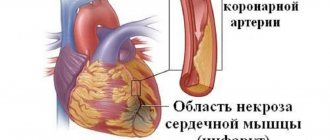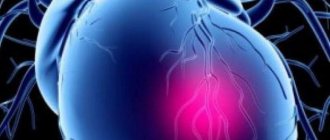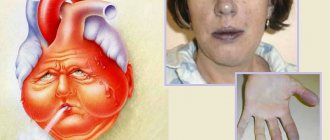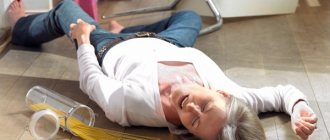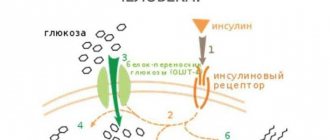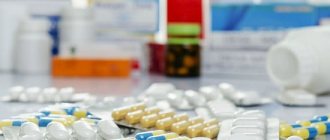Algori
Nosebleeds are a common pathological condition that complicates the course of many diseases. It can occur due to injury, hypertension, blood clotting disorders, other diseases, as well as during severe physical exertion.
Bleeding in children is not uncommon. Since a child's nose is relatively small and the nasal passages are narrow, the delicate nasal mucosa is very easily injured. In most cases, this is due to damage to the choroid plexus in the nasal septum (90% of cases).
Diagnosis is based on the presence of nosebleeds. When throwing back the head, blood flows down the back wall of the oropharynx or its lateral surfaces, coughing up clots and fresh blood. Possible vomiting of blood with clots. There are bleedings from the anterior (85% of cases) and posterior sections of the nasal cavity.
The amount of bleeding ranges from minor to massive, with signs of acute blood loss appearing. Nosebleeds are not an independent nosological form; they are a symptom of general and local diseases.
general nosebleeds are:
- diseases of the cardiovascular system (hypertension and arterial hypertension), kidney diseases, liver diseases, atherosclerosis;
- coagulopathies, hemorrhagic diathesis, disorders of platelet-vascular homeostasis, systemic blood diseases;
- infectious and viral vasculitis;
- hyperthermia as a result of heat stroke;
- endocrine and neurovegetative vasopathies;
- sudden fluctuations in barometric pressure;
- intense physical activity.
Local causes of nosebleeds:
- any types of injuries to the nose and intranasal structures (including iatrogenic);
- pathological processes leading to dystrophic changes in the mucous membrane of the nasal cavity (atrophic rhinitis, deformation of the nasal septum);
- neoplasms of the nasal cavity (hemangiomas, angiofibromas, malignant neoplasms).
Differential diagnosis includes bleeding from varicose veins of the esophagus, pulmonary and gastrointestinal bleeding, and liquorrhea mixed with blood.
source
Emergency care for nosebleeds
Nosebleeds can occur due to injury, hypertension, bleeding disorders and other diseases, and can also occur during intense physical exertion. Help for nosebleeds should be provided immediately; below in this article we will describe what needs to be done.
Nosebleeds are not a separate disease. This is a symptom of certain diseases not only of the nasal cavity, but also of the body as a whole. The most common cause is injury; severe bleeding can be caused by even a minor blow. Nose picking, which exposes the nasal mucosa to permanent trauma, can also cause bleeding. Diseases such as chronic runny nose, malignant and benign tumors of the nose predispose to the occurrence of nosebleeds.
conclusions
- Most often, bleeding occurs due to physical impact on the nasal mucosa or its dryness.
- If the discharge of blood is of high intensity and lasts more than 20 minutes, you should seek urgent medical attention.
- With moderate and low intensity, you can stop the nosebleed on your own.
- If a similar situation occurs with a small child, make sure that there are no foreign objects in the nasal cavity. You should not try to remove objects from your nose on your own.
- If this problem occurs regularly, contact a specialist. This may be a signal of serious illness.
If your nose bleeds, it must be stopped. You should immediately consult a doctor for emergency help in the following cases:
- If the bleeding is intense and does not stop for more than 30 minutes.
- If it began after a severe head injury.
- If the blood is watery, mixed with yellowish fluid.
Bleeding that is prolonged can be dangerous to health.
Possible causes and symptoms of nosebleeds
- Increased body temperature due to acute infectious diseases, sunstroke or heatstroke, overheating.
- Diseases of the cardiovascular system.
- Coagulopathies, diseases of the blood system, vitamin deficiencies, hypovitaminosis.
- Sudden changes in barometric pressure.
- Hormonal imbalances (for example, during pregnancy).
- Physical overexertion.
- A sharp decrease in atmospheric pressure.
Symptoms of nosebleeds:
- Discharge of scarlet blood from the nasal openings
- Blood flows down the back of the throat.
- Blood is released from the nose in a stream or drops.
- Bloody vomiting can occur when blood is swallowed and enters the stomach.
- If bleeding does not stop for a long time, a pre-fainting or fainting state occurs, the skin turns pale, cold sweat appears, the heartbeat increases, and blood pressure drops.
Therefore, if you have a nosebleed, you should get emergency help as quickly as possible.
Bleeding is the outflow of blood from a blood vessel when the integrity or permeability of its wall is damaged.
Bloody nose when you should see a doctor
You should definitely consult a doctor if your nose bleeds periodically or you cannot stop the bleeding.
Nosebleeds (epistaxis) can be anterior or posterior. The anterior one is easy to stop, and in theory there can be no complications, unless it is constantly repeated.
But it is almost impossible to stop posterior bleeding without a doctor! The burst vessel is located far inside and all your manipulations will be useless. Such bleeding is very dangerous and occurs extremely rarely. For example, in case of serious illness, during an accident, during a fall from a height, in a word, during a very powerful blow!
In such a situation, there is no point in sitting and waiting for the bleeding to stop on its own. Urgently go to the hospital, God forbid that this happens, but perhaps you will make every minute count!
Emergency care for nosebleeds: algorithm
When providing emergency care, first of all, you need to calm the patient. This is very important, because with excitement the heart rate increases, and this accordingly increases nosebleeds. First aid for nosebleeds - the algorithm is as follows.
1. Place the patient in a comfortable position so that his head is higher than his body. Tilt your head slightly forward so that blood does not enter the mouth and nasopharynx.
2. Explain to the patient that you should not blow your nose when bleeding, as this can only increase the bleeding. In addition, you should not tilt your head back; in this position, blood flows down the back wall of the throat.
3. Press the wing of the nose against the septum. Before this, cotton swabs moistened with 0.1% naphthyzine, 3% hydrogen peroxide solution, or dry ones can be inserted into the nasal passages. Let the patient breathe through his mouth.
4. Apply cold to the bridge of your nose and the back of your head for 20 minutes.
This is the algorithm for providing emergency care for nosebleeds. Sometimes it is necessary to see a doctor; you will need a doctor if:
- The blood does not stop and flows heavily even after first aid has been provided for 15-20 minutes. Call an ambulance.
- The patient suffers from diabetes, bleeding disorders, and high blood pressure.
- The patient regularly takes aspirin, ibuprofen, and heparin.
- Bloody vomiting occurred as a result of blood getting into the throat.
- A pre-syncope or fainting state occurred.
- Nosebleeds recur quite often.
- Bleeding appeared after a severe head injury or fall.
In case of prolonged continuous nosebleeds, cauterization of the nasal mucosa is performed in the hospital. After some time, a scar forms at the cauterization site.
source
Folk remedies
Thanks to traditional medicine recipes, you can provide first aid for nosebleeds at home. But all methods are not effective for complicated pathology. After providing first aid, you should seek further treatment from a doctor.
Common barberry
With the help of the plant, you can strengthen the walls of blood vessels and get rid of periodic hemorrhages in the nose. It is enough to infuse 7 grams of crushed dry barberry in 250 ml of water. After the characteristic color of the liquid appears, it is cooled and the nose is washed three times a week.
The vegetable is used for bleeding as an antimicrobial agent that suppresses the inflammatory process well. Raw turnips are grated, the juice is squeezed out and taken orally immediately after hemorrhage. The standard dosage is a tablespoon 2-3 times a day.
Horsetail
Horsetail decoction provides good assistance in the prevention of hemorrhages. To do this, a small amount of the plant is brewed in 500 ml of water. The drug is cooled to room temperature and the nose is washed or instilled generously.
Pathological bleeding requires immediate treatment. They pose a threat to health and significantly reduce quality of life. Be sure to use first aid in case of heavy blood loss.
Editor: Oleg Markelov
Rescuer of the Main Directorate of the Ministry of Emergency Situations of Russia in the Krasnodar Territory
Emergency care for nosebleeds
Sitting position with head tilted forward. Gauze packing of both nasal passages. Cold on the nasal area (a vessel with cold water or pieces of ice), press the outside of the nasal passage with your finger along with a tampon to the nasal septum.
Tamponade of the nasal passages with thin gauze strips soaked in hydrogen peroxide. Instead of hydrogen peroxide, you can use any vasoconstrictor drops (for a runny nose).
Medical emergency care
Anterior or posterior tamponade. Blood pressure control.
120. Emergency care for fainting, shock collapse
.
Lay on your back, raise your legs at an angle of 15°, inhale ammonia, inject 1 ml of 10% caffeine or 2 ml of cordiamin intravenously, 30 mg of prednisolone intravenously. collapse
The sick person is placed in a horizontal position, preferably with the leg end raised.
The volume of circulating blood is replenished with available solutions (intravenously, drip), but solutions of polyglucin, venofundin, halofusin, which have an anti-shock effect, are recommended. It is also necessary to use drugs belonging to the group of pressor amines (increasing blood pressure) - mezaton, norepinephrine, it is also possible to use caffeine, cordiamine. If there is no effect, a solution of prednisolone is administered intravenously, in a stream or drip - 60-90 mg. shock
- eliminate the cause. . Place the patient in a horizontal position with the lower limbs raised. 2. Ensure patency of the upper respiratory tract - remove foreign bodies from the oropharynx, tilt the head back, remove the lower jaw,
• in case of bleeding, stop external bleeding using tamponade, bandages, hemostatic clamps, clamping of large arteries, a tourniquet with recording the time of its application; • in case of traumatic pain syndrome: immobilization; pain relief intravenously, intramuscularly with a 50% analgin solution at a dose of 0.1 ml/year of life or even, if necessary, with a 1% solution of promedol at a dose of 0.1 ml/year of life, administration of crystalloids in a volume of 10-20 ml/kg ( Ringer's solutions, 0.9% sodium chloride) and colloids (reopolyglucin, polyglucin, 5% albumin, Gecodez, gelatinol, Gelofusin).. 5. In the presence of acute adrenal insufficiency, hormones are prescribed:
• hydrocortisone 10-40 mg/kg/day; • or prednisolone 2-10 mg / kg / day, with half the daily dose in the first administration, and the other half - evenly throughout the day.
6. In case of hypoglycemia, administer a 20-40% glucose solution at a dose of 2 ml/kg intravenously.
Prevention
It is necessary to strengthen blood vessels using the following procedures:
- Rinse the sinuses with saline solution (2 teaspoons of sea or ordinary salt per 200 ml of water).
- Crusts in the nostrils must be softened with Vaseline oil and removed only after they have softened.
- It is recommended to use “Ascorutin” or medications that strengthen the walls of blood vessels.
- B vitamins must always be present in the diet (high amounts of them in citrus fruits, currants, rose hips).
- For preventive purposes, doctors recommend supplementing the menu with vitamin juice or green tea, as they boost immunity well.
- Hardening procedures are a long-tried method of strengthening blood vessels; a contrast shower has an excellent effect on them.
Emergency care for anaphylactic shock
the patient should be placed on a horizontal surface. The head should be placed on one side. To prevent the tongue from retracting into the pharynx, the lower jaw must be fixed in some way. If a reaction to intravenous administration of the drug develops, apply a tourniquet slightly above the injection site. 1. The main drug of choice is Adrenaline 0.1%. It is important to introduce it as soon as possible.
Any route of administration: subcutaneous, intradermal, intramuscular and, best of all, intravenous. The initial dosage is 0.3−0.5 ml. In the future, if necessary, you can enter 1−1.5 ml 2. Following Adrenaline, glucocorticoids are administered. The drug and its dosage:
Methylprednisolone - 500 mg, Dexamethasone - 20 mg, Prednisolone - 150 mg.
administration of antihistamines, drugs:
Diphenhydramine 1% - 1−2 ml, Suprastin or Chloropyramine 2% - 2 ml, Tavegil or Clemastine 0.1% - 2 ml.
4. When signs of pulmonary edema or bronchospasm (difficulty breathing) occur, a solution of Eufillin 2.4% - 10 ml is slowly injected.
source
What you need to know
Bleeding of various localizations often serves as a reason to seek emergency medical help. The causes of bleeding can be different. From a simple injury to more serious health problems. It is not always possible to establish the cause of bleeding if it is not known about any chronic disease that caused this condition. Then they limit themselves to clarifying the location and severity of bleeding, taking local pre-medical measures to stop bleeding and combat the consequences of blood loss.
Each of us has experienced a nosebleed at least once in our lives, either ourselves or someone around us. The situation is simple, but its health consequences can be quite serious and even dangerous. Let's figure out together what nosebleeds are, what their causes and possible consequences are, and also consider the rules for providing emergency care for nosebleeds.
Among spontaneous bleeding from the upper respiratory tract, nosebleeds are in first place in frequency. The nasal membrane is rich in blood vessels, which determine the frequency of nosebleeds in different categories of people.
However, not all bleeding from the external openings of the nose indicates epistaxis. The latter can often be bleeding from the deeper respiratory tract, as well as from the esophagus or stomach.
In children or debilitated patients, bleeding may go unnoticed if the blood flows into the throat. In such cases, vomiting blood or coughing up blood is often the first sign of a nosebleed.
When is hospitalization necessary?
If, after all the efforts made, the child’s nosebleeds cannot be stopped even after half an hour, and the person’s skin becomes significantly pale and acquires a yellowish tint, he should be urgently hospitalized in a medical facility for an in-depth examination.
It should be noted that if the victim has a history of hypertension, the onset of bleeding against the background of a hypertensive crisis acts as a protective mechanism, since it helps to reduce blood pressure.
In such cases, in addition to standard actions to stop blood loss, the patient must be given an antihypertensive drug, which he takes constantly, and then taken to the hospital.
Causes
Local
- Traumatic injuries to the nose. They occupy first place among all causes of bleeding. Minor injuries include scratches, abrasions, damage to the nasal membrane by the patient's fingers when removing crusts, as well as injuries during sports or other activities.
- Acute and chronic runny nose. Nosebleeds are a frequent companion to chronic sinusitis, rhinitis, and adenoids. May occur when the nasal septum is deviated.
- Foreign bodies in the nasal cavity and sinuses. When a foreign body is introduced, the nasal mucosa is damaged, causing light bleeding. Bleeding can also occur after a long stay of a foreign body in the nasal cavity, with the formation of granulations.
- Surgical interventions.
- Bleeding due to ulcerations in the nasal cavity. Sometimes observed in chrome production workers or in people working with strong acids.
- Infiltrates of the nasal mucosa of a tuberculous or syphilitic nature can cause slight ichorous discharge.
- Benign or malignant neoplasms. Of the benign tumors, the most common cause is a bleeding polyp of the nasal septum, as well as papillomas, lymphomas, and angiomas. Bleeding from angiofibromas of the nasopharynx (often in men aged 13-26 years) should be considered serious. The first sign of this disease is frequent night bleeding.
Are common
- Cardiovascular diseases (hypertension, atherosclerosis, heart defects).
- Infectious diseases (typhoid fever, influenza, scarlet fever, malaria, as well as whooping cough during a severe cough).
- Hormonal imbalance. Observed in teenage girls with menstrual irregularities. Often found in amenorrhea and hypomenstrual syndrome.
- Diseases associated with stagnation in the circulatory system (emphysema, liver and kidney diseases, as well as pregnancy).
- Hemorrhagic diathesis (hemophilia, vasculitis, Werlhof's disease, thrombasthenia).
- Diseases of the hematopoietic organs (leukemia, hemocytoblastosis).
- Bleeding as a result of changes in atmospheric pressure while in the mountains, deep under water.
- Uncontrolled use of anticoagulants.
- Heatstroke or sunstroke
Symptoms
Stopping nosebleeds
In some cases, nosebleeds can begin suddenly, against the background of complete health, sometimes even during sleep; in other cases, patients note increasing symptoms: headache, tinnitus, weakness, dizziness, weakness. The blood from nosebleeds is clear and bright red. If bleeding was preceded by a head injury, and blood flows from the nasal cavity in a yellowish color, you should urgently consult a doctor, as this may indicate a fracture of the base of the skull. Sometimes the bleeding can stop spontaneously, but sometimes it can continue for a long time, causing a drop in pulse rate and fainting.
Some bleeding may go unnoticed due to blood draining down the back of the throat. Such bleeding is mainly typical for children or bedridden patients. Increasing pallor, weak rapid pulse, and bloody vomiting indicate the presence of such bleeding.
The diagnosis does not present any particular difficulties. It is more difficult to determine the source of bleeding. In cases where it is not possible to detect a bleeding area in the nasal cavity, it is necessary to find out whether this bleeding is nasal bleeding, or indicates deeper lesions of other organs or systems.
Treatment of nosebleeds in adults and children consists of various methods of stopping existing bleeding, as well as timely treatment of chronic diseases that cause these phenomena.
What do nosebleeds mean?
As a rule, the clinical picture of bleeding consists of symptoms of bleeding itself, consequences (signs of blood loss in the case of severe hemorrhage) and signs of some disease. We will not touch on the signs of diseases, but will analyze the bleeding clinic and the manifestations of blood loss.
Signs of bleeding
With anterior bleeding, they are obvious: the appearance of drops of blood. With posterior bleeding, this is the appearance of bloody saliva, a feeling of nausea and fullness of the throat, a bloody cough, and vomiting of gastric contents.
If the blood is fresh, then there may be vomiting of blood, and if some time has passed, then the blood coagulates, like coffee grounds. Sometimes nosebleeds manifest as a symptom such as headache, especially against the background of a hypertensive crisis.
It is especially dangerous if there is bleeding from the nose at night and this bleeding is posterior: a person can choke on blood, inhale it, and develop aspiration pneumonia.
Signs of progressive blood loss
Symptoms of impending shock include:
- decreased blood pressure;
- pallor;
- sweating (cold clammy sweat);
- ringing (noise) in the ears, flashing “flies” before the eyes;
- weakness, faintness; the appearance of tachycardia and a weak, thread-like pulse;
- the occurrence of shortness of breath.
About complications
The most common and serious complication is hemorrhagic shock caused by excessive blood loss. The second complication is the occurrence of aspiration pneumonia when inhaling and choking on blood.
After the hemorrhage stops, a cough, chest pain, and fever arise. The x-ray shows signs of focal darkening of the lung tissue.
When blood is swallowed in significant quantities, vomiting develops, which increases intra-abdominal pressure, which increases bleeding.
Diagnostics
In diagnosis, it is important to establish the source of bleeding. This is determined by the ENT doctor, performing anterior and posterior rhinoscopy
At home, mistakes are possible: bleeding from the esophagus or from the lungs is possible.
In the first case, blood will appear “from below” when the body is in a vertical position, and a napkin inserted into the mouth will become saturated with blood not from above, but from below. In the second case, the blood will be scarlet, foamy, saturated with air.
The patient may have a cough, wheezing, or bubbling in the chest (for example, with pulmonary edema and cardiac asthma).
Urgent Care
Emergency care for nosebleeds
- Make the patient sit down. Calm down. Press the wing of the nose against the nasal septum with your finger. Keep your head straight, do not let your head fall back.
- Place cold on the bridge of your nose (ice from the refrigerator, frozen food, a lump of snow, a wet cold towel).
- Insert a cotton swab soaked in 3% hydrogen peroxide or aminocaproic acid into the nasal passage. You can remove the tampon after 10-15 minutes.
- If all of the above measures are unsuccessful, then a small piece of hemostatic sponge should be inserted into the nasal passage. There is no need to remove it later.
- Provide peace to the victim, and for children, distracting activities in a calm environment (reading books, watching cartoons) so that the child does not move or stand for half an hour.
- After the bleeding stops, you should consult a doctor for a more detailed examination of the reasons that caused this condition. If you suffer from any chronic disease, tell your doctor about it.
Under no circumstances should you:
- When bleeding, tilt your head back;
- Take a horizontal position;
- Instill any drops into the nose;
- After the bleeding stops, blow your nose and check your nasal passage with your fingers;
- Over the next 24 hours, perform intense physical exercises, especially those involving bending your head and lifting weights;
The prognosis of nosebleeds, if they are not profuse, are rare and do not affect the general condition, is most often favorable. If you doubt that you can provide assistance yourself, call an ambulance. You can find out how to properly call an ambulance in our article.



